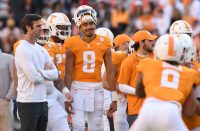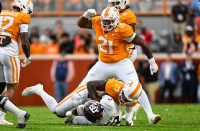Last week, we showed why your intuition that bigger was better along the defensive front was indeed true, and then gave you some good news, namely that Tennessee’s defensive front was getting bigger under Jeremy Pruitt.
We also know, though, that making progress isn’t the same as achieving your goals. After all, you can improve dramatically and still finish in last place. You could double the size of my eight-year-old daughter, but she’s still not going to be very effective at trying to slow down D’Andre Swift.
So, where do the Vols stand relative to the competition when it comes to the cumulative size of its defensive front? Is it the size it actually needs to be, or does it still have a ways to go?
More good news: Tennessee’s projected starting defensive front seven is now the size it needs to be.
2019 defensive front weights for Tennessee and its SEC opponents
Below is a list of the cumulative weight of Tennessee’s projected starting defensive front seven for 2019, along with those of its 2019 SEC opponents. Beware, these are based on projected starting lineups, and there’s necessarily a lot of guesswork involved in making such projections. But I’ve found that swapping one or two guys out for each other generally doesn’t produce a dramatic difference in the cumulative weight of the entire front seven. Unless you’re Kentucky and you have a whale in the middle, in which case it matters a lot. And in any event, informed guessing is all we have at this point.
Here’s the list:
| Team | Weight |
| Alabama | 1892 |
| Georgia | 1890 |
| Tennessee | 1889 |
| Kentucky | 1854 |
| Missouri | 1840 |
| Mississippi State | 1815 |
| South Carolina | 1813 |
| Vanderbilt | 1810 |
| Florida | 1785 |
Tennessee in the top tier
The cumulative weight of Tennessee’s projected starting front seven on defense for 2019 is essentially identical to that of both Alabama and Georgia. There’s a signifcant gap between those three teams and the rest of the teams on the list, as the Big Three are all around 1,890 pounds, and the next tier — Kentucky and Missouri — are between 1,840 and 1,854. As alluded to above, Kentucky’s is impacted greatly by monstrous 361-pound Quinton Bohanna. If you substitute a normally-large nose tackle for him, the team’s cumulative weight drops all the way down to around 1,800 pounds. That is one big dude.
The next tier includes Mississippi State, South Carolina, and Vanderbilt, which range from 1,810 to 1,815 pounds. The Gators are in their own category, down at 1,785 pounds, apparently preferring speed over heft at this point.
The Vols’ projected lineup
As we said last week, we’re basing Tennessee’s number here on a projected starting lineup that looks like this:
| Player | Weight |
| Emmit Gooden | 302 |
| Aubrey Solomon | 306 |
| Savion Williams | 315 |
| Darrell Taylor | 255 |
| Daniel Bituli | 243 |
| Darin Kirkland/Will Ignont | 225-229 |
| Deandre Johnson | 241 |
In my mind, that’s the most reasonable projection, but it does include some assumptions, including that Aubrey Solomon’s request for immediate eligibility is approved and that both he and No. 1 JUCO DT Williams earn the starting spots with Gooden. If that’s all true, then Tennessee has three 300-pounders starting on the defensive line of scrimmage. Not even Alabama has that. Georgia is the only other team on this list with three projected starters over the 300-pound threshold.
Mission accomplished in short order
In 2017, before Pruitt arrived, the front seven weighed in at 1,817 pounds, which would put them in the third tier on the above list with Mississippi State, South Carolina, and Vanderbilt. In Pruitt’s Year 1, they were 1,866 pounds, which would put them at the top of the second tier with Kentucky and Missouri but still far from the top.
But now, in Pruitt’s Year 2, the cumulative weight of his projected starting defensive front seven looks no different than that of Alabama and Georgia.
To be sure, there’s a lot more to effective play along the defensive front than size, and the guys still need to develop all of the requisite techniques and skills needed to become an elite defensive front.
But if there are boxes to be checked on the way to that goal, consider this one checked. Tennessee’s defensive front now has the right size guys.



